A few months ago, we reviewed the Beelink GTR5. We recently purchased its successor, the Beelink GTR6, thanks to our STH YouTube members. While it may seem like that is only a small update, the differences are absolutely massive. In this review, we are going to take a look at the Beelink GTR6 and see how it sports not just a new, faster AMD Ryzen 9 6900HX processor but also has undergone a massive re-design in a familiar form factor.
Beelink GTR6 Background
With this review, we also have a video. That allows us to show a few more aspects of the system. We also have noise testing live so you can hear the fan noise since that is a big story with this unit. We also show off the size of this unit compared to the Intel NUC 12 Pro Wall Street Canyon.
As always, we suggest opening this in its own browser, tab, or app for the best viewing experience.
These units typically go on sale for around $750-850 these days, depending on the coupons. There is quite a bit of variation based on the sales going on, as we have seen different promotions run over the past few months.
That price includes the system, power supply, motherboard, WiFi 6E, a 512GB NVMe SSD, 32GB of DDR5 memory, and the AMD Ryzen 9 6900HX processor. The processor may seem like it is the biggest difference, but there is a lot more going on here. We also have Windows 11 Pro installed so we did not have to source an OS.
We tried several configurations beyond what we received in the box. We are using our trusty G.Skill 2x 32GB DDR5-4800 SODIMM kit for 64GB here (Amazon affiliate link.) We also tried 2x 8GB and 2x 16GB configurations. While we are using the 64GB configuration, realistically, we think many of our readers will stick with a 32GB configuration.
Pricing is very important with this unit. Last week it was selling for $850 ($899-50 coupon) on Amazon. This week it is $959-140 or $819. That still feels a bit high, given the Minisforum U690 in a similar 32GB/512GB configuration is currently $731. We will be reviewing that unit soon. There are certainly reasons to pick one over the other from what we have seen, but a $90 price delta is a bit steep.
Beelink GTR6 External Hardware Overview
The front of the GTR6 looks fairly similar to the GTR5. We get two USB ports a Type-A and Type-C port. There is also a nice headset combo jack. There is also a power button that lights up when it is on. The strange feature is the CLR CMOS button next to the power button. If one hits the wrong button, then they are clearing CMOS instead of powering the unit on/ off. This is similar to the GTR5, and in both cases, it feels wrong.
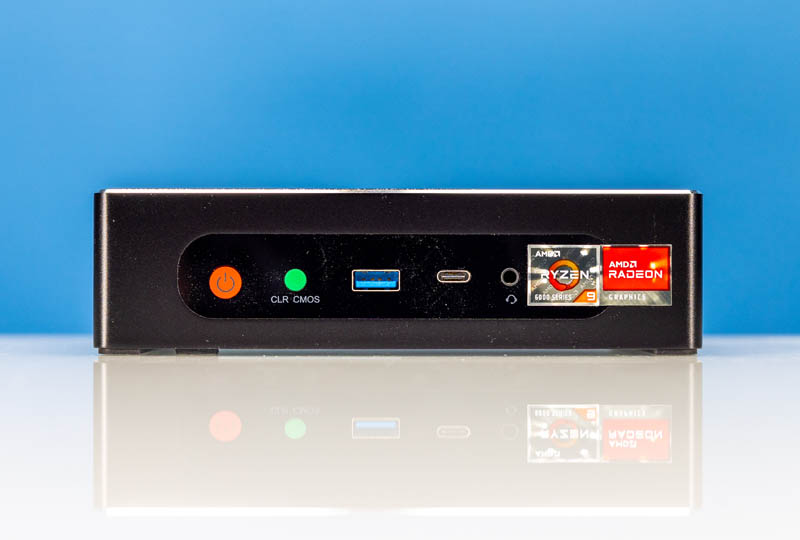
Beelink proudly displays the AMD Ryzen 9 6000 series logo and the AMD Radeon logo. This is much more subdued branding than the previous generation.
Moving to the rear, we see a major rework. There is a single Intel i225-V 2.5GbE port for LAN. Then there are FOUR HDMI ports. Beelink advertises the fact that this can handle 4x 8K displays heavily. Finally, there are two USB 3 and two USB 2 ports.
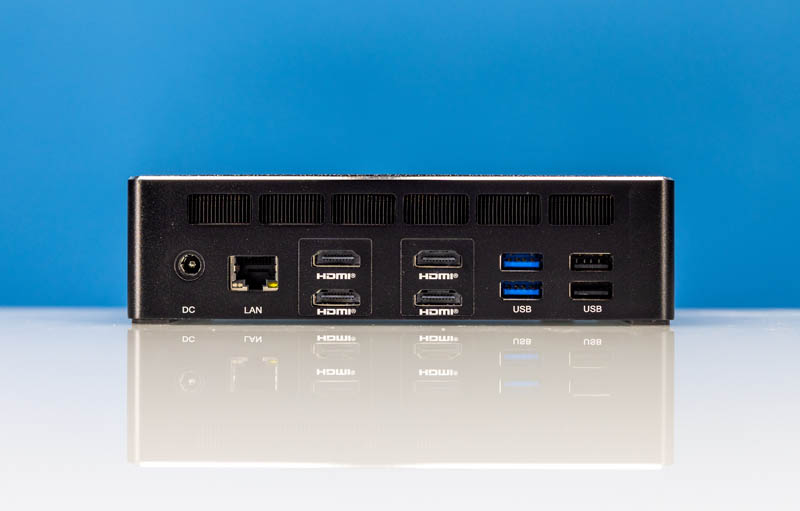
Just for some sense, here is the GTR5 version’s rear panel:
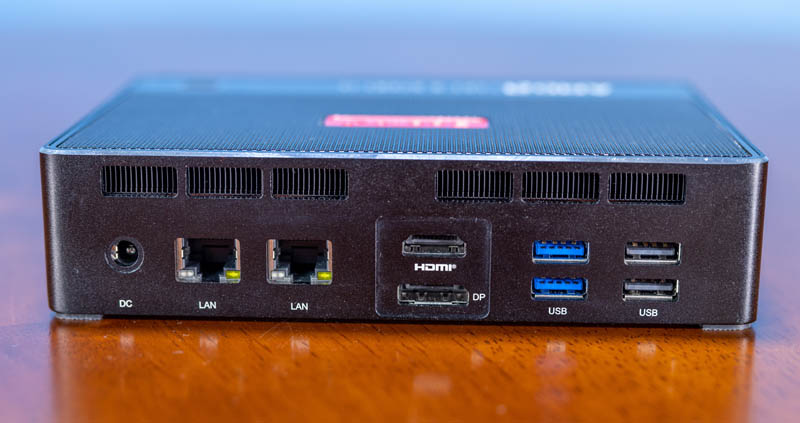
We can see that Beelink sacrificed the second LAN port for two HDMI outputs and also standardized HDMI across all outputs.
The sides of the unit are mesh vents with GTR lettering.
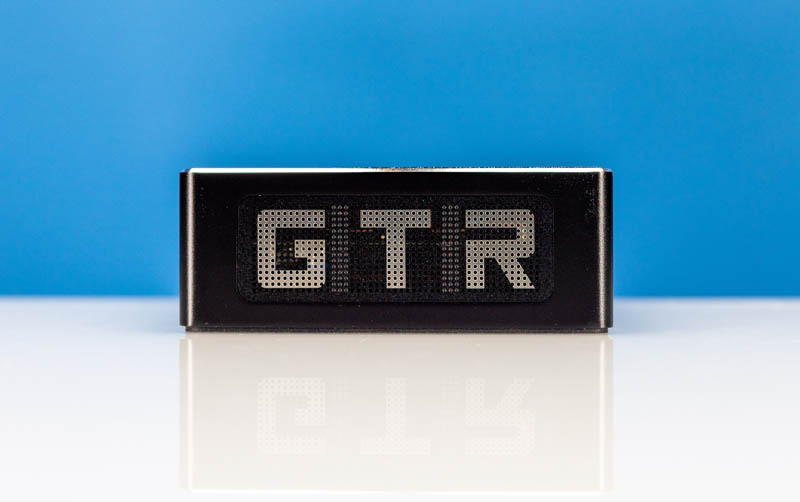
The top of the unit is interesting for a few reasons. One is that this unit has a fingerprint reader. Windows 11 Pro prompts one to setup fingerprint authentication on its initial setup. Beware, if you intend to use this as a HTPC and it is next to a TV, then it is annoying to have to hit that fingerprint reader on the box. While the Apple Mac Mini (review soon as well) does not have a built-in fingerprint reader on the box, that is because Apple tends to place these near input devices like keyboards.
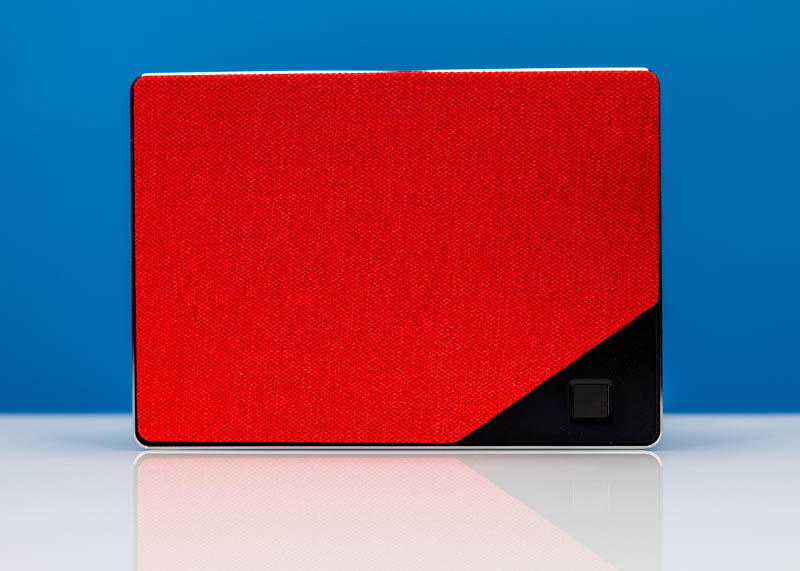
That bright red top does away with the heavy AMD branding we saw atop the GTR5. As cool as it looks in photos, there are many rooms where it will stand out too much. For that, Beelink offers a second option.
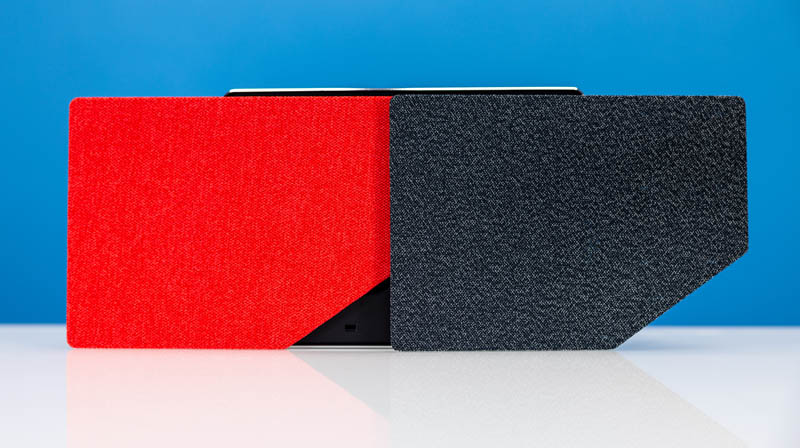
Pry off the red cover, and there is a much more subtle top cover. While not as eye-catching for photos, it feels more practical.
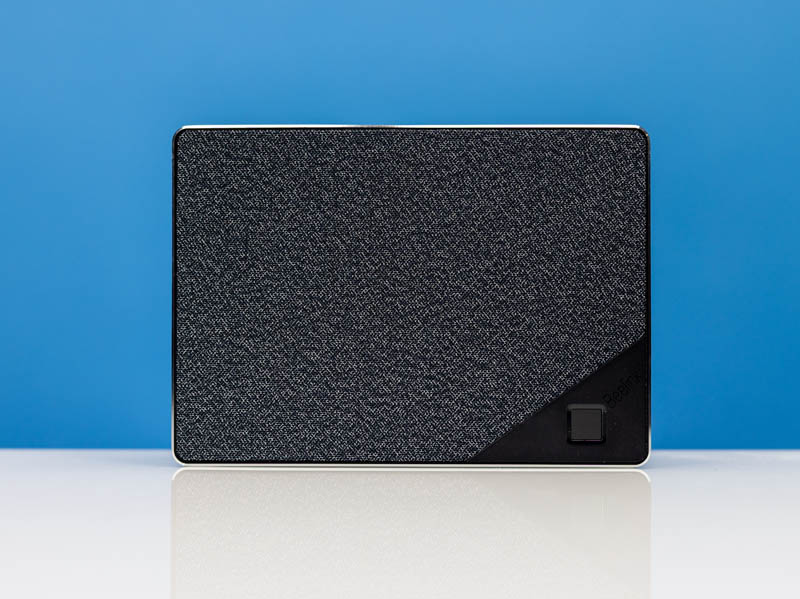
Under this cover is a single fan instead of the dual fan solution used by the GTR5. We generally like the idea of fewer larger fans.
The bottom of the unit has Beelink’s large rubber strips to prevent scratching. Somewhat differently, there is a guide saying “Delete” for BIOS and “F7” for boot options screened on the bottom of this unit.
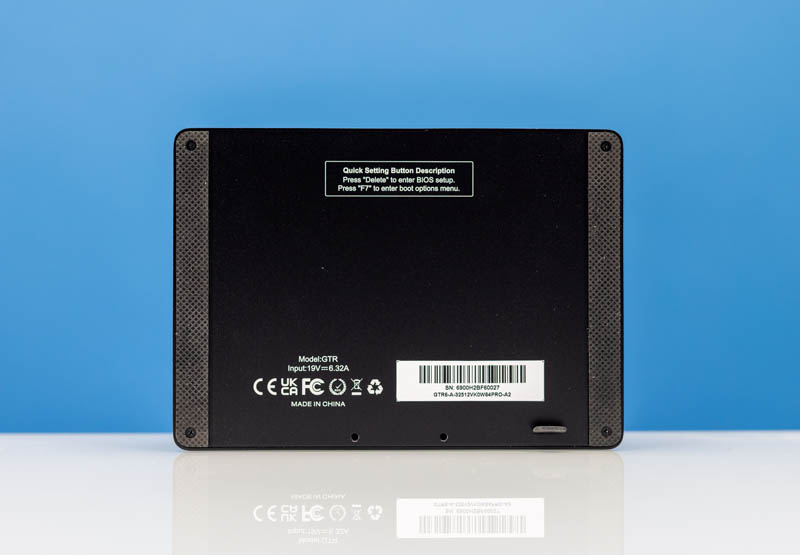
The four screws around the edges are what allow one to get inside the unit.
Next, let us get inside the unit, then look at performance.

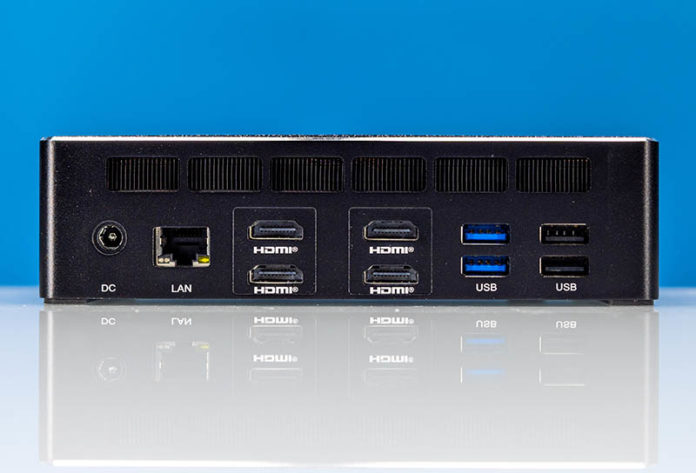



No mention of ECC support or lack thereof?
When it comes to the benchmarks and you have 2 columns for one entry (like with the 7zip compression) could you make the subject CPU a different color so that it stands out more like how you change the subject CPU to black in all the other benchmark scores?
That fan looks shockingly small.
Not sure what these manufacturers are thinking. I had a NUC and a Gigabyte Brix about 8 years ago. Every year I look at newer NUC-type devices but noise only got better.
Noise levels should be a priority and slightly bigger systems with bigger coolers won’t hurt nobody.
Lasertoe:
Yes exactly. No one cares about 1-2 cm thickness, but everyone hears the noise. I don’t understand manufacturers.
Is there any advantage to sticking with a barrel plug on these aside from their BOM cost? Surely a 100W USB-C PD cable would have been a more sensible solution. They could have used the same power brick with a fixed cable but with a USB-C plug instead of a barrel plug (like Lenovo does) and limited tuned it down to 100W at 20V instead of 120W at 19V, or kept to the newest USB-C PD standard using 140W at 28V and give more head room.
I have one of the previous model, GTR5, bought largely on the basis of its review here at STH.
It is an impressive little box. For 10 to 50 watts it shows up full power desktop processors of just a generation back. Adding a 2TB 2.5″ SSD was easy.
The Beelink name makes sense as the fan sounds like an annoyed bee if pushed. This is rarely an issue for me as I use it in my living room to run a TV. Most uses do not trigger the fan. If I push it and the fan bugs me I can set the powersave governor and it shuts up at lower but still good performance. Would I want a bigger box for less fan noise? Yes.
Everything works in Windows, except, well, Windows. I use it in Linux where it serves despite some issues.
With a nice old 4k monitor 60Hz only works with displayport and no sound. This is true of the USB-C displayport mode and the native displayport plug. HDMI only gets 30Hz on native cables, same with conversion to displayport. I spent long hours down the EDID rathole with no resolution. I think the answer is Windows has tables of quirks for monitors and the AMD Linux drivers do not. Perhaps if I got the right EDID I could have made it work.
The WiFi has great throughput but 50ms latency. Works right in Windows. Wired ethernet works all around.
HDMI to a TV, only a few months newer than the 4k monitor, works all around, 4k, 60Hz, sound, everything. Just have to make sure the TV is already turned on when the Beelink boots up or, well, reboot it.
I would anticipate similar results with the GTR6, great performance for tiny power in a tiny box but annoying video issues in Linux. HDMI only is a step back.
Price of these things feels a lot like a robbery. It’s essentially SoC on aboard with a few connectors FFS – no special chipset etc etc. And yet they are pricing it as if it were complete notebook.
One might be better off by waiting for new APUs to come out and then going for mini-ITX board and perhaps adding some periphery (10G Eth etc etc).
True that no AM5 MoBop has 4 GFX outputs, but that’s what the DP MST HUB is about…
I think Ansi is right, but it’s also a problem of them changing prices all the time. At $750 you’d have $225 for the SSD and RAM and then it’s $525 for the rest. CPU, motherboard, case, power supply and Windows 11 Pro for that isn’t too bad. Let’s also take that you don’t have to order and assemble and install Windows so it’ll save time too.
At $850 it’s too much of a premium and I’d agree with Ansi
If you are willing to accept STX systems (size bigger than NUC but smaller than mini-ITX) but want a cheap, small and low noise system Asrocks Deskmini is probably the way to go.
I have one X300 here and with a Noctua NH-L9a noise is pretty good. A newer B660 is available too. AMD X600 & Intel B760 should arrive soon.
It doesn’t look as cool as those small NUC-type systems though.
Just another comment agreeing on the fan situation.
Why can’t they just design these things to make use of a STANDARD format fan (e.g. 120x120x25mm). Sure it’d make the thing slightly larger, but one such fan can be effective for quite a bit of power with very little noise (if the air path is designed properly). And it’s replaceable!!! Users can pick & choose their own fans, for different priorities, like noise or reliablility.
Oh, and as mentioned by another commenter, no ECC support??
No wonder I just stick to my own mini-ITX builds. My current low-power home server has just one 120mm fan, has ECC memory, and is powered by DC supply (M3-ATX).
Great review. I will get a GTR6 Ryzen 9 (or maybe the Ryzen 7) based on this review. Previously your GTR5 review pointed me to the Beelink Mini’s. I purchased multiple SER5 Ryzen 5 5600U’s. Really solid Win11 Pro PC’s. Came with Kingston & Crucial 16GB memory. New SER5’s have 32GB. Mine have NVMe 512GB or 1TB drives. The basement has room for an SSD. Only 1GB NIC but all are connected with 2.5GB adapters connected to a USB and QNAP & Synology network servers. Drives multiple monitors at each desk. Looking forward to the GTR6. Latest I’ve seen on Amaz.: GTR6 Ryzen 9 ($970), GTR6 Ryzen 7 ($585), SER5 Ryzen 5 ($369). Thanks again for the Beelink Mini update.
Its extremely noisy even in idle, I wish reviews actually pointed this out more, because it’s a huge deal